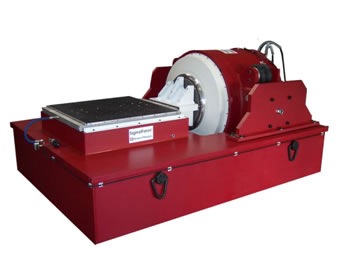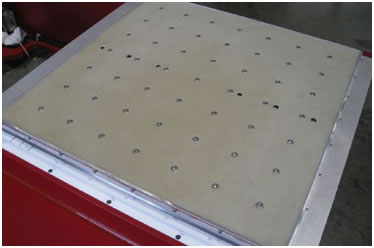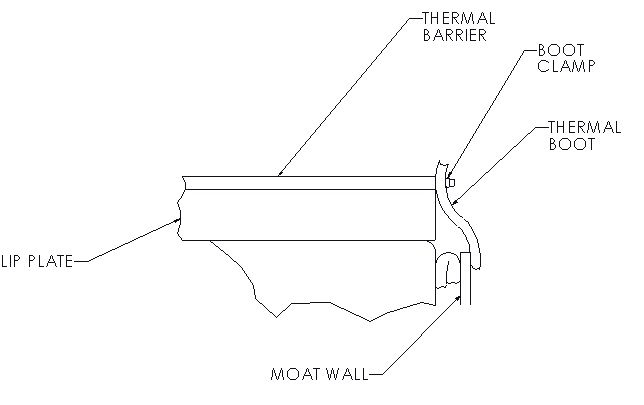Issues to Consider for Slip Tables in Thermal Environments
There are a few issues to consider when using slip tables in thermal environments. While configuring slip tables for standard thermal tests is straightforward, more extreme temperature testing can cause complications that will require configuration by factory personnel. Additionally, thermal expansion of fixtures can present problems depending on the conditions and fixtures.
In most cases, a slip table is used to conduct three axis vibration testing. Three axis testing typically requires the shaker to be rotated from vertical to horizontal. Most often, one axis of vibration is conducted with the shaker in the vertical and the two remaining axes are conducted with the shaker in the horizontal position coupled to a slip table system. Below is a photo of a typical monobase slip table assembly produced by Data Physics.

Types of Slip Tables for Horizontal Testing in Thermal Environments
There are various types of slip tables available for horizontal testing and most are designed to operate in a thermal environment. Data Physics offers three types of table systems: oil film, linear guided, and hydrostatic bearing guided. The hydrostatic bearing guided tables can incorporate high pressure journal bearings or low pressure T-Film bearings.
Temperature Ranges for Shaker Testing
When testing in thermal environments, it is critical to know the temperature range. Once the temperature range is known, appropriate thermal barriers can be proposed for the application. A thermal barrier is recommended on both the shaker armature and slip table. If a head expander is used, it is recommended that a separate thermal barrier be used for the head expander.

At times, test labs will try to resist using thermal barriers on slip tables. There are several good reasons for using thermal barriers:
- Isolating the vibration test equipment from extreme temperatures which can possibly alter material properties over a period of time
- Protecting from and absorbing moisture
- Protecting the slip table from corrosion
- Allowing attachment of the chamber boot

The operational temperature range for the standard G10 thermal barrier is -40°C to +120°C. Other thermal barriers are available for more extreme temperature ranges. For even more extreme temperature conditions, custom tables are manufactured that include cooling or heating inside the slip table. These are configured and priced individually.
All SignalForce slip plates are manufactured from magnesium. Consequently, a significant concern is the condensation produced during the thermal cycling. The condensation creates a corrosive environment for the magnesium. Several issues can arise if the slip plate is not protected from the condensation: the inserts can fail, the counter-bored holes with pressed fitted washers can rise and fail, and the magnesium mounting surfaces can pit and flake. Eventually, the slip plate will fail because the customer will not be able to attach components to the slip plate or even attach the slip plate to the shaker.
Another area of concern when conducting horizontal testing in a thermal environment is material expansion and contraction of fixtures. This is a particularly significant concern when using large fixtures that are made of material other than magnesium. To save costs (and not have magnesium in corrosive environments), large fixtures are often made of aluminum. These fixtures typically have a base plate that attaches to the slip plate and reaches from one bearing supported area to a second bearing supported area. The difference in the thermal expansion of the aluminum fixture, which is in the thermal environment, and the magnesium slip plate, which is outside the thermal environment, can cause the bearings to bind.
For these reasons, it is important to understand a customer’s entire test methodology. Knowing the entire test plan, including the temperature range and fixtures to be used, can help to address potential problems before they happen. At a minimum, it is important to always propose thermal barriers when combining any vibration test system with thermal testing.

